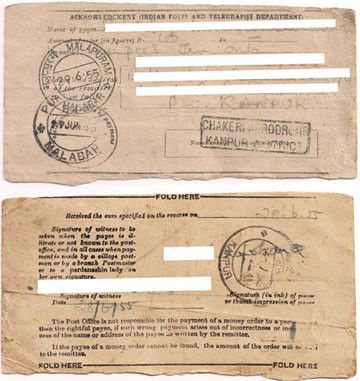Articles features
End of a legacy: Money Order goes the telegram way

New Delhi/Mumbai/Kolkata, April 4
A
135-year-old legacy comes to an end! Like in the case of the telegram,
India Post has quietly discontinued the traditional money order service,
which was an integral part of the department since 1880, facilitating
pan-India door-delivery of funds to a payee from over 155,000 post
offices.
In an era of instant communications, the traditional
money transfer facility has made way for an electronic version, which
was introduced in October 2008, thanks to the proliferation of mobile
telephony and data communications in the country through the internet -
18 months after they led to the demise of the telegram.
"Yes, the
traditional money order as we know it has been discontinued," said
Shikha Mathur Kumar, deputy director general for finance with India Post
based in the national capital. "What we have now are electronic money
orders, or eMO, and instant money orders, or iMO, systems," Kumar told
IANS.
"Both these are much faster and simpler means to remit money."
The
iMO system, according to India Post, provides instant money order
service for amounts ranging from Rs.1,000 to Rs.50,000. An instant,
web-based system, money can be remitted by designated iMO post offices -
where an electronic version of a form is filled along with an identity
proof.
Once the money is transferred electronically, along with
one of the 33 standard messages that can be chosen by the remitter, the
payee can visit the post office and receive the money on producing a
proof of identity. The money can also be be credited to the savings bank
of a payee.
In the case of eMO, money is paid at the door-step
of a payee - from Rs.1 to Rs.5,000 - within a day, along with 21
standard messages. It is booked at an authorised post office and
delivered pan-India from all delivery post offices. This can also be
tracked on the India Post website.
But for many, especially the
senior citizens, the end of the traditional money system - which was
withdrawn from April - did evoke a sense of nostalgia and, to an extent,
some sadness as well.
"I would send money through money orders
to my family in a village Madhya Pradesh," recalled K. Abdulhussein, a
retired printing manager, now settled in Mumbai. "My folks back home
would wait for it. In fact, the village postman was an important man.
But what happens now," he wondered.
When the new, electronic
system of money order was explained, Abdulhussein told IANS that the
move was expected. "People today have two bank accounts - a salary
account and a personal account. Then there are mobile phones. Everyone
has it. So the old system had to go."
A similar sentiment was
shared by R.R. Pandya, a retired 80-year-old banker in Mumbai, who also
recalled having regularly sent funds through the traditional money order
system to his parents in Gujarat.
"They were more comfortable
dealing with the friendly neighbourhood postman. You had this option of
sending money with messages. So, during marriages, we would send Rs.11,
Rs.21, Rs.51 - along with congratulatory messages."
For Kanai Lal
Ghosh, a retired teacher in Kolkata, yesteryear memories and
contemporary India's reality present contrasting pictures. "I'd send
funds only by way of money orders to my parents. Now my son does it
instantly, from his mobile phone. I presume old ways are redundant now."
According
to information provided by India Post, the money order system was
transferred from the official treasury department to the Posts and
Telegraph Department in 1880 to save people the ardour of long journeys
they had to often undertake to pay revenues and rent.
This was
when Rai Saligram Bahadur, the second guru of the Radhasoami faith, was
the postmaster-general of the North-Western Provinces, based out of
Allahabad. He was the first Indian to hold that post and money order was
one of the many firsts he brought to the table.
From a mere 283
such transactions at that time, it grew to 108 million by the time the
service was in vogue for 100 years in 1980. The numbers dropped to
around 95 million when the eMO and iMO schemes were launched and even
further now, officials said.







































